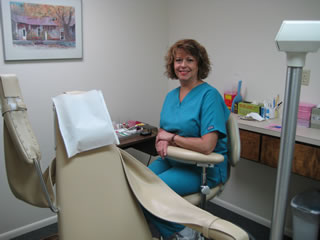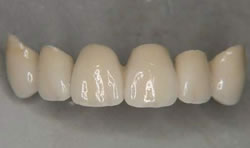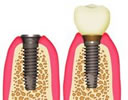Sealants:
Sealants protect the grooved and pitted surfaces of the teeth, especially the chewing surfaces of back teeth where most cavities in children are found. Made of clear or shaded plastic, sealants are applied to the teeth to help keep them cavity-free.
Sealants are most often applied on teeth of children, however, adults can benefit from sealant application as well.
Even if your child brushes and flosses carefully, it is difficult—sometimes impossible—to clean the tiny grooves and pits on certain teeth. Food and bacteria build up in these crevices, placing your child in danger of tooth decay. Sealants "seal out" food and plaque, thus reducing the risk of decay.
Research shows that sealants can last for many years if properly cared for. This affords your child protection throughout the most cavity-prone years. If your child has good oral hygiene and avoids biting hard objects, sealants will last longer. Dr. Hartigan will check the sealants during routine dental visits and recommend re-application or repair when necessary.

Extractions:
Although permanent teeth were meant to last a lifetime, there are a number of reasons why tooth extraction may be needed. The most common is a tooth that is too badly damaged, from trauma or decay, to be repaired. Some other reasons include a crowded mouth, infection, risk of infection or gum disease.
Sometimes, to prepare the mouth for orthodontia, a tooth may need to be pulled. Orthodontia means to properly align the teeth. This may not be possible if your teeth are too big for your mouth, in which case an extraction might be necessary. Also, if a tooth cannot break through the gum because there is not room in the mouth for it, an extraction might be recommended.
If infection or tooth decay extends to the pulp (which is the center of the tooth containing nerves and blood vessels), allowing bacteria to contaminate the pulp, extraction might be necessary.
The risk of infection in a particular tooth may be another reason for extraction. An example of this, even though extreme, would be if your immune system is possibly compromised by receiving chemotherapy or if you are having an organ transplant.
Finally, gum disease which has caused severe loosening of the teeth may be an instance where an extraction would be necessary.
Composite Filings:
To treat a cavity, the decayed portion of the tooth must be remove and then "filled" with a dental filling material. Several dental filling materials are available. Teeth can be filled with gold, porcelain, silver amalgam or tooth colored plastic/glass material called a composite resin.
Fillings are also used to repair cracked or broken teeth and teeth that have been worn from misuse such as nail biting or tooth grinding.
The location and extent of the decay, cost of the filling material, your insurance coverage and our recommendation can assist in determining the type of filling that will best address your needs.
Crowns:
Crowns are typically used to restore a tooth's function and appearance following a restorative procedure such as a root canal. When decay in a tooth has become so advanced that large portions of the tooth must be removed, crowns are often used to restore the tooth.
Crowns are also used to attach bridges, cover implants, prevent a cracked tooth from becoming worse, or if an existing filling is in jeopardy of becoming loose or dislocated.
Crowns also serve an aesthetic use, and are applied when a discolored or stained tooth needs to be restored to its natural appearance.
A tooth must usually be reduced in size to accommodate a crown. An impression is made of the existing tooth and the impression is then sent to a special lab, which manufactures a custom-designed crown. A temporary crown is applied until the permanent crown is ready. The permanent crown is then cemented in place.
With proper oral hygiene and care, a good quality crown can last up to ten years or longer.
Bridges (Full / Partial):
 Dental bridges literally bridge
the gap created by one or more missing teeth. Bridges can restore your smile, restore your ability to properly chew
and speak and maintain the normal shape of your face.
Dental bridges literally bridge
the gap created by one or more missing teeth. Bridges can restore your smile, restore your ability to properly chew
and speak and maintain the normal shape of your face.
 Very important long term
positive results of a bridge are that it helps distribute the forces in your bite properly by replacing missing teeth
and it can prevent remaining teeth from drifting out of position. There are three main types of dental bridges: Traditional,
Cantilever and Maryland bonded bridges.
Very important long term
positive results of a bridge are that it helps distribute the forces in your bite properly by replacing missing teeth
and it can prevent remaining teeth from drifting out of position. There are three main types of dental bridges: Traditional,
Cantilever and Maryland bonded bridges.
Traditional bridges involve creating a crown for the tooth or implant on either side of the missing tooth, with a pontic in between. Traditional bridges are the most common type of bridge and are made of either porcelain fused to metal or ceramics.
Cantilever bridges are used when there are adjacent teeth on only one side of the missing tooth or teeth.
Maryland bonded bridges, also called resin-bonded bridges are made of plastic teeth and gums supported by a metal framework. Metal wings on each side of the bridge are bonded to your existing teeth.
A bridge is made up of two crowns for the teeth on either side of the gap – these two anchoring teeth are called abutment teeth – and a false tooth/teeth in between. These false teeth are called pontics and can be made from gold, alloys, porcelain, or a combination of these materials. Dental bridges are supported by natural teeth or implants.
 Implants:
Implants:
Before development of dental implants, dentures were the only alternative to replacing a missing tooth or teeth. Implants are synthetic structures that are placed in the area of the tooth normally occupied by the root.
Implants are anchored to the jawbone and act as a foundation for an artificial tooth or permanent bridge. In some cases, implants can be used to attach dentures.
Implants mimic the look and feel of natural teeth and are made of bio compatible materials. A surgical procedure is necessary to place implants in the mouth. Following the procedure, a period of time is required for the bone around the implant to adhere tightly to the implant. Once this osseointegration is complete the abutment and crown are prepared and placed on the implant.
Our implants are surgically placed by a qualified oral surgeon or periodontist.
Dentures:
Dentures are a removable replacement for missing teeth and surrounding tissues. They are made of acrylic resin sometimes combined with metal attachments. Complete dentures replace all the teeth; partial dentures are considered when some natural teeth remain and are retained by metal clasps attached to the natural teeth.
 Complete dentures can be either "conventional" or "immediate".
Made after the teeth have been removed and the gum tissue has begun to heal, a conventional denture is ready for
placement in the mouth about 8 to 12 weeks after the teeth have been removed.
Complete dentures can be either "conventional" or "immediate".
Made after the teeth have been removed and the gum tissue has begun to heal, a conventional denture is ready for
placement in the mouth about 8 to 12 weeks after the teeth have been removed.
Unlike conventional dentures, immediate dentures are made in advance and can be positioned as soon as the teeth are removed. As a result, the wearer does not have to be without teeth during the healing period.
However, bones and gums shrink over time, especially during the healing period following tooth removal. Therefore a disadvantage of immediate dentures compared with conventional dentures is that they require more adjustments to fit properly during the healing process and generally should only be considered a temporary solution until conventional dentures can be made.
A removable partial denture or bridge usually consists of replacement teeth attached to a pink or gum-colored plastic base, which is connected by metal framework that holds the denture in place in the mouth. Partial dentures are used when one or more natural teeth remain in the upper or lower jaw. A fixed (permanent) bridge replaces one or more teeth by placing crowns on the teeth on either side of the space and attaching artificial teeth to them. This "bridge" is then cemented into place. Not only does a partial denture fill in the spaces created by missing teeth, it prevents other teeth from changing position. A precision partial denture is removable and has internal attachments rather than clasps that attach to the adjacent crowns. This is a more natural-looking appliance.
 Root
Canal Therapy:
Root
Canal Therapy:
Often dental decay infections spread to the pulp, which is the inner chamber of the tooth containing blood vessels, nerves and other tissues. A traumatic injury to a tooth can also compromise the pulp, leading to similar problems. A diseased inner tooth brings a host of problems; pain and sensitivity are some of the first indications of a problem; but inside, a spreading infection can cause small pockets of pus to develop, leading to an abscess. Root canal therapy (endodontic therapy) is a technique used to save a diseased or damaged tooth. The alternative to a root canal would be an extraction or removal of the tooth. Treatment requires that the nerve inside the tooth be removed and replaced with a solid filling material that is resistant to infection.
Most of our root canal therapy is referred to a qualified endodontist.


